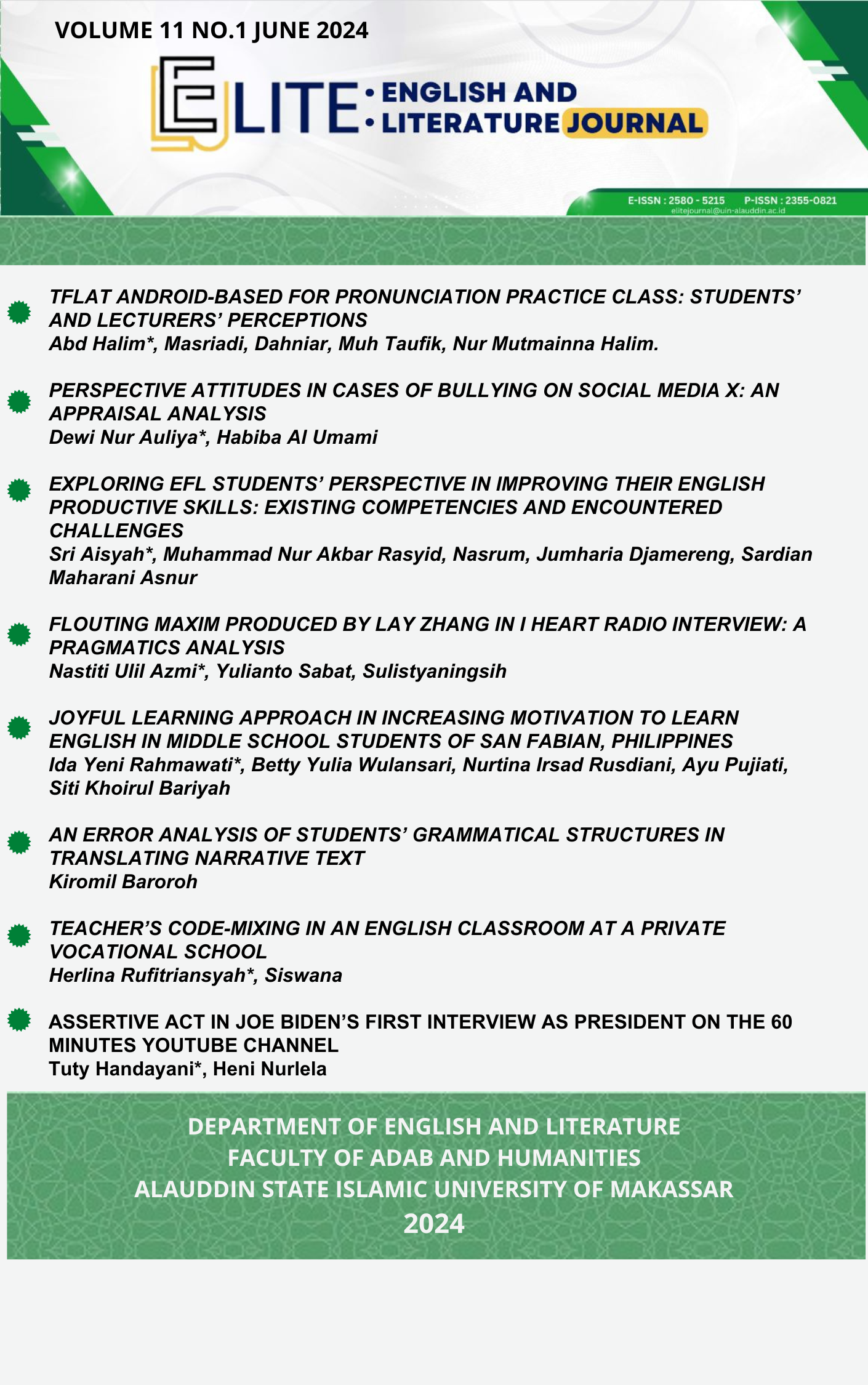TFLAT ANDROID-BASED FOR PRONUNCIATION PRACTICE CLASS: STUDENTS AND LECTURERS' PERCEPTIONS
Abstrak
Penelitian ini menyelidiki persepsi penggunaan aplikasi TFlat English Pronunciation. Penelitian ini bertujuan untuk memahami bagaimana mahasiswa dan dosen memandang aplikasi, dampaknya terhadap pembelajaran bahasa, dan potensi manfaatnya. Penelitian ini menggunakan teori E-Learning yang diadaptasi dari Akaslan dan Law (2010) dan menggunakan metode kualitatif untuk mengeksplorasi pengalaman pengguna yang beragam. Temuan mengungkapkan bahwa siswa menemukan TFlat menjadi aplikasi yang berharga untuk meningkatkan pengucapan bahasa Inggris mereka dalam E-learning. Mereka menghargai fitur yang ramah pengguna dan aksesibilitas TFlat, yang meningkatkan pengalaman E-learning mereka secara keseluruhan. Dosen juga mengakui manfaat TFlat dalam meningkatkan keterampilan pengucapan siswa dan mempromosikan aksesibilitas. Namun, mereka menyarankan untuk mengatasi masalah kompatibilitas dengan iPhone dan memperluas fitur aplikasi untuk praktik yang lebih luas dalam pemanfaatan di masa depan. Secara keseluruhan, penelitian ini menyoroti pentingnya alat teknologi praktis seperti TFlat dalam pendidikan modern dan menekankan perlunya diversifikasi latihan dan aksesibilitas yang lebih luas di seluruh perangkat
##plugins.generic.usageStats.downloads##
Referensi
Adityarini, H., Fahdiansyah, M. F., & Novitasari, V. (2022). Enhancing Students’ Pronunciation Using Android Pronunciation Application. International Conference of Learning on Advance Education (ICOLAE 2021), 828–835.
Akaslan, D., & Law, E. L. C. (2011). Measuring Teachers’ Readiness for E-Learning in Higher Education Institutions Associated With The Subject of Electricity in Turkey. 2011 IEEE Global Engineering Education Conference (EDUCON), 481–490.
Ameri, M. (2020). The use of mobile apps in learning English language. Budapest International Research and Critics in Linguistics and Education (BirLE) Journal, 3(3), 1363–1370.
Bastian, A., & Fathira, V. (2022). Classroom Management in Applying Android Applications as Learning Media in Online Learning: EFL Students’ Perceptions. Al-Ishlah: Jurnal Pendidikan, 14(2), 1887–1902.
Chaeruman, U. A., Wibawa, B., & Syahrial, Z. (2018). Creating a blended learning model for online learning system in Indonesia. International Journal of Engineering & Technology, 7(3.36), 156.
Chen, Y.-J., & Lin, S.-C. (2009). Exploring characteristics for effective EFL teachers from the perceptions of junior high school students in Tainan. 南台人文社會學報, 2, 219–249.
Chinnery, G. M. (2006). Going to the MALL: Mobile assisted language learning.
Drew, S. (2001). Perceptions of what helps learn and develop in education. Teaching in Higher Education, 6(3), 309–331.
Furqan, M. (2022). IMPROVING THE STUDENTS’SPEAKING ACHIEVEMENT THROUGH ANDROID APPLICATION TFLAT ENGLISH TO THE 12th GRADE STUDENTS OF SMA NEGERI 1 PEUSANGAN SIBLAH KRUENG. Journal of English Education and Social Science, 2(2), 48–59.
Jw, C. (1998). Qualitative Inquiry and Research Design. Choosing Among Five Traditions.
Kamal, A. (2023). Higher Students’ Anxiety LevelaAnd Factor in Writing Essays Through Google Docs. SELTICS, 6(1), 1–11.
Kukulska-Hulme, A., & Traxler, J. (2005). Mobile Learning: A Handbook for Educators and Trainers. Psychology Press.
Marshall, C., & Rossman, G. B. (2014). Designing Qualitative Research. Sage publications.
Merriam, S. B., & Tisdell, E. J. (2015). Qualitative Research: A Guide to Design and Implementation. John Wiley & Sons.
Miqawati, A. H. (2020). Pronunciation Learning, Participation, and Attitude Enhancement Through Mobile Assisted Language Learning (Mall). English Review: Journal of English Education, 8(2), 211–218.
Nguyen, L. T., & Newton, J. (2021). Enhancing EFL Teachers’ Pronunciation Pedagogy Through Professional Learning: A Vietnamese Case Study. RELC Journal, 52(1), 77–93.
Rezaei, A., Mai, N., & Pesaranghader, A. (2014). The Effect of Mobile Applications on English Vocabulary Acquisition. Jurnal Teknologi, 68(2), 73–83.
Rookes, P., & Willson, J. (2005). Perception: Theory, Development and Organisation. Routledge.
Stockwell, G. (2022). Mobile Assisted Language Learning: Concepts, Contexts and Challenges. Cambridge University Press.
Su, Y., Feng, L., Hsu, C.-H., & Yang, C.-C. (2013). Technology As An Activity System for Self-Directed, Expanding Learning: An Analysis Based on Activity Theory. Procedia-Social and Behavioral Sciences, 106, 2575–2582.
Sutton, J., & Austin, Z. (2015). Qualitative Research: Data collection, Analysis, and Management. The Canadian Journal of Hospital Pharmacy, 68(3), 226.
Taufik, M., Rijal, A. S., Dahniar, D., & Apriani, E. (2021). The Effectiveness of Learning English Using LMS Google Classroom during Covid-19 Pandemic. Al-Ishlah: Jurnal Pendidikan, 13(2), 960–970.
Traxler, J. (2018). Learning With Mobiles in The Digital Age.
##submission.copyrightStatement##
##submission.license.cc.by-nc-sa4.footer##Once an article was published in the journal, the author(s) are:
granted to the journal right licensed under Creative Commons License Attribution that allows others to share the work with an acknowledgement of the work's authorship.
permitted to publish their work online in third parties as it can lead wider dissemination of the work.
continue to be the copyright owner and allow the journal to publish the article with the CC BY-NC-SA 4.0 license
receiving a DOI (Digital Object Identifier) of the work.


